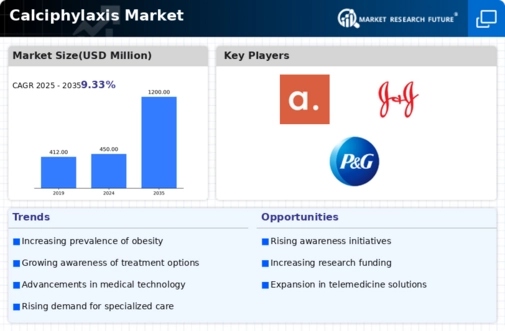Market Growth Projections
The Global Calciphylaxis Market Industry is projected to experience substantial growth over the coming years. With a market value of 450 USD Million in 2024, it is anticipated to reach 1200 USD Million by 2035, reflecting a robust CAGR of 9.33% from 2025 to 2035. This growth trajectory is indicative of the increasing recognition of calciphylaxis as a critical health issue, necessitating focused research and treatment efforts. The market's expansion is likely to be driven by a combination of factors, including rising prevalence rates, advancements in medical research, and enhanced awareness among healthcare professionals.
Increased Awareness and Education
There is a growing awareness and education surrounding calciphylaxis among healthcare professionals and patients, which is contributing to the expansion of the Global Calciphylaxis Market Industry. Enhanced educational initiatives and training programs are being implemented to improve the understanding of this rare but serious condition. As healthcare providers become more knowledgeable about calciphylaxis, they are better equipped to diagnose and manage the disease effectively. This increased awareness is likely to lead to earlier detection and treatment, which may positively impact market growth, as evidenced by the projected CAGR of 9.33% from 2025 to 2035.
Aging Population and Comorbidities
The aging global population is another critical factor driving the Global Calciphylaxis Market Industry. As individuals age, they are more likely to develop comorbid conditions such as diabetes and hypertension, which are risk factors for calciphylaxis. The demographic shift towards an older population is expected to increase the prevalence of calciphylaxis, thereby expanding the market. With the global population aged 65 and older projected to reach 1.5 billion by 2050, healthcare systems must adapt to address the needs of this demographic. This trend suggests a sustained demand for calciphylaxis treatments, further stimulating market growth.
Regulatory Support and Policy Initiatives
Regulatory support and policy initiatives aimed at improving patient care for calciphylaxis are likely to bolster the Global Calciphylaxis Market Industry. Governments and health organizations are increasingly recognizing the need for guidelines and frameworks to manage calciphylaxis effectively. Such initiatives may include funding for research, development of treatment protocols, and support for healthcare providers. This regulatory environment can facilitate market entry for new therapies and encourage innovation in treatment options. As a result, the market could experience significant growth, aligning with the broader goals of enhancing healthcare delivery and patient outcomes.
Rising Prevalence of Chronic Kidney Disease
The increasing incidence of chronic kidney disease (CKD) is a primary driver of the Global Calciphylaxis Market Industry. As CKD progresses, patients often develop secondary hyperparathyroidism, which can lead to calciphylaxis. In 2024, the market is projected to reach 450 USD Million, reflecting the urgent need for effective treatment options. The World Health Organization indicates that CKD affects approximately 10 percent of the global population, suggesting a growing patient base susceptible to calciphylaxis. This trend underscores the necessity for healthcare providers to focus on early diagnosis and management strategies, thereby propelling market growth.
Advancements in Medical Research and Treatment
Ongoing advancements in medical research are significantly influencing the Global Calciphylaxis Market Industry. Innovative therapies and treatment modalities are being developed to address calciphylaxis more effectively. For instance, recent studies have explored the efficacy of sodium thiosulfate in treating calciphylaxis, showing promising results. As research continues to evolve, the market is expected to expand, potentially reaching 1200 USD Million by 2035. This growth is indicative of the increasing recognition of calciphylaxis as a serious condition that requires targeted therapeutic approaches, thereby enhancing patient outcomes and driving market dynamics.









Leave a Comment